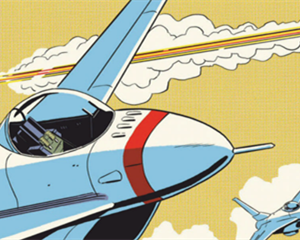Aerial combat
空戰
Virtual mavericks
虛擬小牛
Fighter aircraft will soon get AI pilots. But they will be wingmen, not squadron leaders
戰斗機很快就會有人工智能飛行員,不過他們只是僚機駕駛員,并非空軍少校
Classic dogfights, in which two pilots match wits and machines to shoot down their opponent with well-aimed gunfire, are a thing of the past. Guided missiles have seen to that, and the last recorded instance of such duelling was 32 years ago, near the end of the Iran-Iraq war, when an Iranian F-4 Phantom took out an Iraqi Su-22 with its 20mm cannon.
傳統空戰中,雙方駕駛員拼的是智慧和武器,炮火瞄準將對方擊落。這種時代已經成為過去。導向飛彈已經可以做到這一點。據記載,最后一次此類空戰發生在32年前,兩伊戰爭接近尾聲時伊朗的F-4幻影用它那20毫米的機關炮干掉了伊拉克的蘇-22。
But memory lingers, and dogfighting, even of the simulated sort in which the laws of physics are substituted by equations running inside a computer, is reckoned a good test of the aptitude of a pilot in training. And that is also true when the pilot in question is, itself, a computer program. So, when America's Defence Advanced Research Projects Agency (DARPA), an adventurous arm of the Pentagon, considered the future of air-to-air combat and the role of artificial intelligence (AI) within that future, it began with basics that Manfred von Richthofen himself might have approved of.
不過記憶猶存。即便是用計算機中運行的方程式代替物理定律的模擬比賽,空戰仍被認為是對訓練中的飛行員能力的一個很好的測試。當試驗者本身就是一個計算機程序時,情況也是如此。因此,當美國國防部高級研究計劃局(DARPA)(五角大樓的冒險部門)考慮空對空作戰的未來以及人工智能(AI)在未來的作用時,它會從曼弗雷德·馮·希特霍芬本人可能認同的基礎原理開始。

In August eight teams, representing firms ranging from large defence contractors to tiny startups, gathered virtually under the auspices of the Johns Hopkins Applied Physics Laboratory (APL) in Laurel, Maryland, for the three-day final of DARPA's AlphaDogfight trials. Each had developed algorithms to control a virtual F-16 in simulated dogfights. First, these were to be pitted against each other. Then the winner took on a human being.
8月,在約翰霍普金斯應用物理實驗室的贊助下,代表著從大型國防承包商到小型初創公司等不同集團的8個團隊聚集在馬里蘭州的勞雷爾市,參加DARPA“阿爾法狗之戰”為期三天的決賽。他們分別開發了算法在模擬空戰中控制一架虛擬F-16戰斗機。首先這些戰斗機要相互廝殺。然后獲勝者和人類較量。
Dropping the pilot?
將飛行員扔下去?
"When I got started", says Colonel Dan Javorsek, who leads DARPA's work in this area, "there was quite a bit of scepticism of whether the ai algorithms would be up to the task." In fact, they were. The winner, created by Heron Systems, a small firm in the confusingly named town of California, Maryland, first swept aside its seven digital rivals and then scored a thumping victory against the human, a pilot from America's air force, in five games out of five.
DARPA這一領域的負責人丹·賈沃塞克上校表示:開始時我對人工智能算法能否勝任這項任務抱有相當大的懷疑。”事實的確如此。獲勝者由“蒼鷺系統(Heron Systems)”公司創造,這家小公司位于馬里蘭州的一個有著奇怪名字的加州小鎮。它先是橫掃了七個數碼對手,然后以五局全勝的戰績完勝人類,即一位來自美國空軍的飛行員。
譯文由可可原創,僅供學習交流使用,未經許可請勿轉載。











